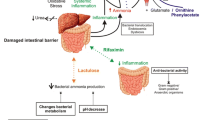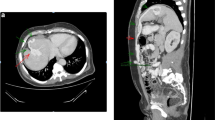Abstract
The role of portal-systemic shunting and portal liver hypoperfusion in the pathophysiology of central nervous system dysfunction of cirrhosis is not yet well defined. It is well known that one of the most important collateral vessels (CV) is a patent paraumbilical vein (PUV) but there is controversy regarding its clinical significance. We have evaluated the relationships between neuropsychological and EEG alterations, ammonia plasma level (NH4), hepatic function, and portal hemodynamics (Doppler Ultrasound) in 95 cirrhotic patients. Patency, diameter, or flow of PUV or the presence of other CV were not related to an increased prevalence of neuropsychological or EEG abnormalities. Patients with effective portal flow (EPF = portal flow – PUV flow) lower than 692 mL/min (median) had a significantly higher risk of failing the neuropsychological test, or of having an altered EEG. Low EPF and prothrombin time (<50%), and high NH4 (≥51 μmol/L) were independent predictors of an abnormal EEG. Considering both low EPF and the numerosity of CV, only low EPF was found to explain EEG alterations. In conclusion, portal liver hypoperfusion and decreased liver function were associated with an increased risk of central nervous system dysfunction in cirrhotic patients, whereas PUV patency per se was not.
Similar content being viewed by others

REFERENCES
Amodio, P., Del Piccolo, F., Marchetti, P., Angeli, P., Iemmolo, R., Caregaro, L., et al. (1999a). Clinical features and survival of cirrhotic patients with subclinical cognitive alterations detected by the number connection test and computerized psychometric tests. Hepatology 29:1662-1667.
Amodio, P., Marchetti, P., Del Piccolo, F., de Tourtchaninoff, M., Varghese, P., Zuliani, C., et al. (1999b). Spectral versus visual EEG analysis in mild hepatic encephalopathy. Clin. Neurophysiol. 110:1334-1344.
Amodio, P., Del Piccolo, F., Pettenò, E., Mapelli, D., Angeli, P., Iemmolo, R., et al. (2001). Prevalence and prognostic value of quantified electroencephalogram (EEG) alterations in cirrhotic patients. J. Hepatol. 35:37-45.
Bolognesi, M., Sacerdoti, D., Merkel, C., Bombonato, G., Enzo, E., and Gatta, A. (1997). Effects of chronic therapy with nadolol on portal hemodynamics and on splanchnic impedance indices using Doppler sonography: Comparison between acute and chronic effects. J. Hepatol. 26:305-311.
Conn, H.O., Leevy, C.M., Vlahcevic, Z.R., Rodgers, J.B., Maddrey, W.C., Seeff, L., et al. (1977). Comparison of lactulose and neomycin in the treatment of chronic portal-systemic encephalopathy. A double blind controlled trial. Gastroenterology 72:573-583.
Dokmeci, A.K., Kimura, K., Matsutani, S., Ohto, M., Ono, T., Tsuchiya, Y., et al. (1981). Collateral veins in portal hypertension: Demonstration by sonography. AJR Am. J. Roentgenol. 137:1173-1177.
Finucci, G., Bellon, S., Merkel, C., Mormino, P., Tirelli, M., Gatta, A., et al. (1991). Evaluation of splanchnic angiography as a prognostic index of survival in patients with cirrhosis. Scand. J. Gastroenterol. 26:951-960.
Fischer, C.J., and Faloon, W.W. (1957). Blood ammonia levels in hepatic cirrhosis. N. Engl. J. Med. 256:1030-1035.
Galambos, J.T., Warren, W.D., Rudman, D., Smith, R.B., III, and Salam, A.A. (1976). Selective and total shunts in the treatment of bleeding varices. A randomized controlled trial. N. Engl. J. Med. 295:1089-1095.
Gupta, D., Chawla, Y.K., Dhiman, R.K., Suri, S., and Dilawari, J.B. (2000). Clinical significance of patent paraumbilical vein in patients with liver cirrhosis. Dig. Dis. Sci. 45:1861-1864.
Jalan, R., Elton, R.A., Redhead, D.N., Finlayson, N.D., and Hayes, P.C. (1995). Analysis of prognostic variables in the prediction of mortality, shunt failure, variceal rebleeding and encephalopathy following the transjugular intrahepatic portosystemic stent-shunt for variceal haemorrhage. J. Hepatol. 23:123-128.
Kardel, T., Ramsoe, K., and Norby, R.S. (1975). Preoperative liver function tests correlated with encephalopathy after porta-caval anastomosis. Scand. J. Gastroenterol. 10:29-32.
Klem, G.H., Lüders, H.O., Jasper, H.H., and Elger, C. (1999) The ten-twenty electrode system of the International Federation. In: Deuschal, G., and Eisen, A. (eds.), Recommendations for the Practice of Clinical Neurophysiology: Guidelines of the International Federation of Clinical Neurophysiology, Elsevier, Amsterdam, pp. 3-6.
Kugler, C.F., Lotterer, E., Petter, J., Wensing, G., Taghavy, A., Hahn, E.G., et al. (1992). Visual event-related P300 potentials in early portosystemic encephalopathy. Gastroenterology 103:302-310.
Kugler, C.F., Petter, J., Taghavy, A., Lotterer, E., Wensing, G., Hahn, E.G., et al. (1994). Dynamics of cognitive brain dysfunction in patients with cirrhotic liver disease: An event-related P300 potential perspective. Electroencephalogr. Clin. Neurophysiol. 91:33-41.
Lam, K.C., Juttner, H.U., and Reynolds, T.B. (1981). Spontaneous portosystemic shunt: Relationship to spontaneous encephalopathy and gastrointestinal hemorrhage. Dig. Dis. Sci. 26:346-352.
Lezak, M.D. (ed.) (1995). Neuropsychological Assessment, Oxford University Press, New York.
Martin, M., Zajko, A.B., Orons, P.D., Dodd, G., Wright, H., Colangelo, J., et al. (1993). Transjugular intrahepatic portosystemic shunt in the management of variceal bleeding: Indications and clinical results. Surgery 114:719-726.
Merkel, C., Gatta, A., Zoli, M., Bolognesi, M., Angeli, P., Iervese, T., et al. (1991). Prognostic value of galactose elimination capacity, aminopyrine breath test, and ICG clearance in patients with cirrhosis. Comparison with the Pugh score. Dig. Dis. Sci. 36:1197-1203.
Ochs, A., Rossle, M., Haag, K., Hauenstein, K.H., Deibert, P., Siegerstetter, V., et al. (1995). The transjugular intrahepatic portosystemic stent-shunt procedure for refractory ascites. N. Engl. J. Med. 332:1192-1197. [Published erratum appears in N. Engl. J. Med. 1995 Jun 8;332(23):1587.]
Ohnishi, K., Saito, M., Sato, S., Nakayama, T., Takashi, M., Iida, S., et al. (1985). Direction of splenic venous flow assessed by pulsed Doppler flowmetry in patients with a large splenorenal shunt. Relation to spontaneous hepatic encephalopathy. Gastroenterology 89:180-185.
Piscaglia, F., Gaiani, S., Gramantieri, L., Zironi, G., Siringo, S., and Bolondi, L. (1998). Superior mesenteric artery impedance in chronic liver diseases: Relationship with disease severity and portal circulation. Am. J. Gastroenterol. 93:1925-1930.
Read, A.E., McCarthy, C.F., Ajdukiewicz, A.B., and Brown, G.J. (1968). Encephalopathy after portacaval anastomosis. Lancet 2:999-1001.
Reding, P., Duchateau, J., and Bataille, C. (1984). Oral zinc supplementation improves hepatic encephalopathy. Results of a randomised controlled trial. Lancet 2:493-495.
Richardson, J.E., and Moffat, M. (1953). Glutamic acid in hepatic coma following porta-cava anastomosis. Lancet 2:570-571.
Riggio, O., Balducci, G., Ariosto, F., Merli, M., Pieche, U., Pinto, G., et al. (1989). Lactitol in prevention of recurrent episodes of hepatic encephalopathy in cirrhotic patients with portal-systemic shunt. Dig. Dis. Sci. 34:823-829.
Riggio, O., Merli, M., Pedretti, G., Servi, R., Meddi, P., Lionetti, R., et al. (1996). Hepatic encephalopathy after transjugular intrahepatic portosystemic shunt. Incidence and risk factors. Dig. Dis. Sci. 41:578-584.
Rikkers, L., Jenko, P., Rudman, D., and Freides, D. (1978). Subclinical hepatic encephalopathy: Detection, prevalence, and relationship to nitrogen metabolism. Gastroenterology 75:462-469.
Sabba, C., Merkel, C., Zoli, M., Ferraioli, G., Gaiani, S., Sacerdoti, D., et al. (1995). Interobserver and interequipment variability of echo-Doppler examination of the portal vein: Effect of a cooperative training program. Hepatology 21:428-433.
Sacerdoti, D., Bolognesi, M., Bombonato, G., and Gatta, A. (1995). Paraumbilical vein patency in cirrhosis: Effects on hepatic hemodynamics evaluated by Doppler sonography. Hepatology 22:1689-1694.
Sanyal, A.J., Freedman, A.M., Shiffman, M.L., Purdum, P.P., III, Luketic, V.A., and Cheatham, A.K. (1994). Portosystemic encephalopathy after transjugular intrahepatic portosystemic shunt: Results of a prospective controlled study. Hepatology 20:46-55.
Schrier, R.W., Arroyo, V., Bernardi, M., Epstein, M., Henriksen, J.H., and Rodes, J. (1988). Peripheral arterial vasodilation hypothesis: A proposal for the initiation of renal sodium and water retention in cirrhosis. Hepatology 8:1151-1157.
Sherlock, S., and Dooley, J. (1993). Hepatic encephalopathy. In: Diseases of the Liver and Biliary System, Blackwell Scientific, Oxford, pp. 73-85.
Sherlock, S., Summerskill, W.H.J., White, L.P., and Phear, E.A. (1954). Portal systemic encephalopathy. Lancet 4:453-457.
Spina, G.P., Santambrogio, R., Opocher, E., Pisani-Ceretti, A., Ongari, B., Rashidi, B., et al. (1993). Factors predicting chronic hepatic encephalopathy after distal splenorenal shunt: A multivariate analysis of clinical and hemodynamic variables. Surgery 114:519-526.
Starzl, T.E., Porter, K.A., and Kashiwagi, N. (1975). Portal hepatotrophic factors, diabetes mellitus and acute liver atrophy, hypertrophy and regeneration. Surg. Gynecol. Obstet. 141:843-858.
Subramanyam, B.R., Balthazar, E.J., Madamba, M.R., Raghavendra, B.N., Horii, S.C., and Lefleur, R.S. (1983). Sonography of portosystemic venous collaterals in portal hypertension. Radiology 146:161-166.
Summerskill, W.H.J., Dawson, E.A., Sherlock, S., and Steirer, R.E. (1956). Neuropsychiatric syndrome associated with hepatic cirrhosis and extensive portal collateral circulation. Q. J. Med. 25:245-266.
Wechsler, D. (ed.) (1955). Wechsler Adult Intelligence Scale, The Psychological Corporation, New York.
White, L.P., Phear, E.A., Summerskill, W.H.J., and Sherlock, S. (1955). Ammonium tolerance in liver disease: Observation based on catheterization of hepatic vein. J. Clin. Invest. 34:158-168.
Wilkinson, G.R., and Shand, D.G. (1975). Commentary: A physiological approach to hepatic drug clearance. Clin. Pharmacol. Ther. 18:377-390.
Zoli, M., Iervese, T., Merkel, C., Bianchi, G., Magalotti, D., Marchesini, G., et al. (1993). Prognostic significance of portal hemodynamics in patients with compensated cirrhosis. J. Hepatol. 17:56-61.
Rights and permissions
About this article
Cite this article
Del Piccolo, F., Sacerdoti, D., Amodio, P. et al. Central Nervous System Alterations in Liver Cirrhosis: The Role of Portal-Systemic Shunt and Portal Hypoperfusion. Metab Brain Dis 17, 347–358 (2002). https://doi.org/10.1023/A:1021914003218
Issue Date:
DOI: https://doi.org/10.1023/A:1021914003218



